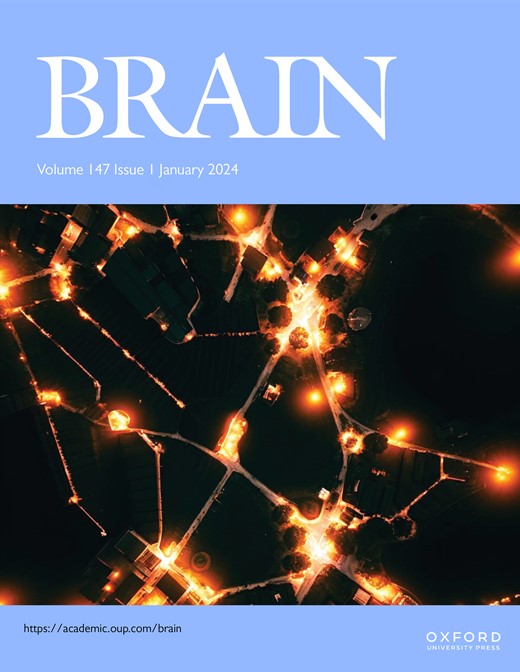A human striatal-midbrain assembloid model of alpha-synuclein propagation.
IF 11.7
1区 医学
Q1 CLINICAL NEUROLOGY
引用次数: 0
Abstract
Animal models of the pathology of Parkinson's disease (PD) have provided most of the treatments to date, but the disease is restricted to human patients. In vitro models using human pluripotent stem cells (hPSCs)-derived neural organoids have provided improved access to study PD etiology. This study established a method to generate human striatal-midbrain assembloids (hSMAs) from hPSCs for modeling alpha-synuclein (α-syn) propagation and recapitulating basal ganglia circuits, including nigrostriatal and striatonigral pathways. Human striatal organoids and midbrain organoids were generated using a stepwise differentiation protocol from hPSCs, and both regionalized neural organoids were assembled to form hSMAs, mimicking some basal ganglia circuits. Both the nigrostriatal and striatonigral pathways were present and the neurons such as dopaminergic (DA) neurons and GABAergic neurons were electrophysiologically active in the hSMAs. hSMA development in the presence of increased α-syn from SNCA overexpression, induced nigrostriatal system damage, which is typical of the disease. Using the α-syn-linker-mKO2 reporter and a bimolecular fluorescence complementation system, we demonstrated that fluorescent α-syn was retrogradely transported from the striatal area to DA neurons of the midbrain area and exhibited α-syn aggregates and Lewy body-like inclusions. Furthermore, phosphorylated and detergent-resistant α-syn aggregates, similar to pathological form in human patients, was accumulated in midbrain area of hSMAs. Treatment with protein aggregation inhibitor (Anle138b) and autophagy inducer (Rapamycin) reduced α-syn aggregation, indicating potential of hSMAs for drug testing. This study established hSMAs as a novel platform for modeling PD, demonstrating α-syn propagation and associated neural pathologies. These assembloids offer significant potential for developing therapeutic strategies and understanding the mechanisms of PD progression.α -突触核蛋白繁殖的人纹状体-中脑组合体模型。
迄今为止,帕金森病(PD)的病理动物模型提供了大多数治疗方法,但该疾病仅限于人类患者。使用人类多能干细胞(hPSCs)衍生的类神经器官的体外模型为研究PD病因提供了更好的途径。本研究建立了一种利用hPSCs生成人纹状体-中脑组装体(hsma)的方法,用于模拟α-突触核蛋白(α-syn)的繁殖和再现基底节区回路,包括黑质纹状体和纹状体神经通路。采用逐步分化的方法,从hPSCs中生成了人类纹状体类器官和中脑类器官,并将这两种区域化的神经类器官组装成hsma,模拟一些基底神经节回路。黑质纹状体和纹状体通路均存在,多巴胺能神经元和gaba能神经元等神经元在hsma中具有电生理活性。在SNCA过表达α-syn增加的情况下,hSMA的发展会引起黑质纹状体系统损伤,这是该疾病的典型特征。利用α-syn-连接体- mko2报告细胞和双分子荧光互补系统,我们证实了荧光α-syn从纹状体区逆行转运到中脑区DA神经元,并表现出α-syn聚集体和路易体样包涵体。此外,在hsma中脑区积累了与人类患者病理形态相似的磷酸化和耐洗涤剂α-syn聚集体。蛋白聚集抑制剂(Anle138b)和自噬诱导剂(雷帕霉素)可降低α-syn聚集,提示hsma具有用于药物检测的潜力。本研究建立了hsma作为PD建模的新平台,展示了α-syn传播和相关的神经病理。这些组合体为开发治疗策略和了解PD进展机制提供了重要的潜力。
本文章由计算机程序翻译,如有差异,请以英文原文为准。
求助全文
约1分钟内获得全文
求助全文
来源期刊

Brain
医学-临床神经学
CiteScore
20.30
自引率
4.10%
发文量
458
审稿时长
3-6 weeks
期刊介绍:
Brain, a journal focused on clinical neurology and translational neuroscience, has been publishing landmark papers since 1878. The journal aims to expand its scope by including studies that shed light on disease mechanisms and conducting innovative clinical trials for brain disorders. With a wide range of topics covered, the Editorial Board represents the international readership and diverse coverage of the journal. Accepted articles are promptly posted online, typically within a few weeks of acceptance. As of 2022, Brain holds an impressive impact factor of 14.5, according to the Journal Citation Reports.
 求助内容:
求助内容: 应助结果提醒方式:
应助结果提醒方式:


